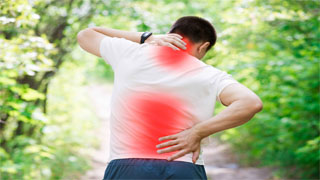
The cervical spine is a very complex area in the spine. It affects the cervical and lumbar vertebrae and is the only area attached to the chest cavity. It is crucial to ensure that this area of the body is healthy and active.
Although we need to pay attention to the stability around the lumbar spine, the thoracic spine requires a certain degree of mobility to ensure the health of the neck and shoulders.
Thoracic anatomy
The thoracic vertebrae are the longest region of the spine, with the cervical vertebrae above and the lumbar vertebrae below. It extends from the bottom of the neck to the abdomen.
The thoracic vertebrae originate directly below the cervical vertebrae C7, forming the middle of this region. C7 is connected to the top of thoracic vertebra T1. This forms the neck chest junction.
The chest region (T1 to T12 vertebrae) is connected to the lumbar spine (lower back) at the L1 vertebra.
The thoracic spine is the only area of the spine that attaches to the chest cavity, making it strong and stable. That's why this area of the spine is less prone to injury.
The lumbar spine lacks such support, and the use of foam shafts should be avoided.
The lumbar spine does not have sufficient support like the thoracic spine. If you have existing spinal diseases, applying additional pressure to the intervertebral discs may worsen the condition.
Soft tissue structure of thoracic vertebrae
Like other parts of the spine, tendons, ligaments, and muscles attach to the thoracic vertebrae, helping to stabilize them during exercise.
Ligament: a connective tissue band that connects bones.
Muscles: Allow the spine to move on different planes of motion, such as forward bending, lateral bending, and backward bending. These movements are called flexion, lateral flexion, and rotation.
Tendon: A sturdy fibrous tissue that connects muscles and bones. They often absorb the impact force on muscles during high impact sports such as running and jumping, and help prevent injuries. However, due to gradual wear and tear, overuse, and misuse, tendons are easily injured.
Thoracic spine health
Corrective exercises and activity training can help you maintain spinal health, strength, and stability. The correct posture will ensure that you will not develop any spinal diseases.
If you feel middle back pain and stiff shoulders, and feel that the pain is affecting your lower back, then the following activity exercises should help address some of these issues.
7 thoracic range of motion exercises for middle back pain
Below are detailed explanations for each exercise.
Thoracic rotation
Starting from being on all fours, place your hands under your shoulders and your knees under your hips.
Place your hands behind your head, rotate outward, move your chest to the side, then rotate inward, and move your elbows towards your hands.
Complete 10-12 repetitions on each side.
Complete this exercise 1-2 times a day.
Stretch chest and rotate
Lie on your side with your hands stretched out in front of you.
Place your upper leg on a roller or wooden block to stabilize your buttocks. We hope to minimize hip movement and focus on spinal rotation.
Lift the upper arm and rotate it outward until it reaches the back. Stretch backwards as much as possible without exerting force.
Complete 10-12 repetitions on each side.
Repeat this exercise twice a day.
Roller thoracic extension surgery
Lie on the foam shaft. Place the roller under the upper back area. Please remember, we do not want to roll the lumbar region.
Extend your arms upwards, parallel to your neck and head. Alternatively, if you feel neck tension, please place your hands behind your back.
By stretching the spine on the roller, rolling the middle back on the cushion, and then returning to the neutral position. Rollers help alleviate tension in the area and move the spine.
Chest extension (roller, chair, bench)
Place the forearm on a roller, bench, or chair. It doesn't matter which tool you use in this exercise.
Stretch your back and slightly arch your back, allowing your chest to naturally land on the floor.
Then lift the ribs slightly
Complete 6-8 repetitions
Wall windmill
Starting from the lunge position, the front legs are close to the wall.
Stretch out one or two arms in front of you.
Keep one arm forward and rotate it in a circular motion above your head while keeping it close to the wall.
Follow the movement of your arms with your head to ensure that you not only move your shoulders, but also your chest area.
Complete 8-12 repetitions on each side, 1-2 repetitions per day.
You can also start by rotating only one arm and gradually transition to both arms:
Cat and Camel (Small Actions)
An important note about this exercise: If you suffer from lumbar disc herniation or feel pain when stretching or bending over excessively, make sure not to arch or bend the spine excessively. Focus on raising the chest and returning to a neutral position.
Starting from being on all fours.
Slightly arch your middle back and release your shoulders, so that your chest will sag. Avoid arching your back.
Slowly return to the starting position and lift the chest and chin towards the chest.
Focus on the middle part of the movement, rather than excessively arching or bending the spine.
Take a deep breath.
Complete ten repetitions and hold the end position for 1-2 seconds.
Repeat this exercise 1-2 times a day as needed.
Dumbbell head training
Take a light dumbbell or barbell plate. I am using a 10 pound dumbbell. Use things that you find easy.
Stand with your feet shoulder width apart. Support your core and gluteal muscles
Maintain hip stability. Grasp the heavy object with both hands, extend your arms, rotate the object around your head once, and finally return to the starting position. Then repeat on the other side.
Make sure to start this movement with the upper back and shoulders. Your core is strong, your hips don't move.
Squeeze your hips for extra lumbar support!


